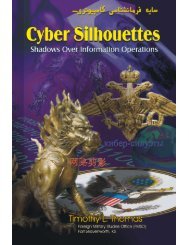History of the Creation of the Republic of Kazakhstan's Airmobile ...
History of the Creation of the Republic of Kazakhstan's Airmobile ...
History of the Creation of the Republic of Kazakhstan's Airmobile ...
Create successful ePaper yourself
Turn your PDF publications into a flip-book with our unique Google optimized e-Paper software.
center. Not just discipline, but also combat readiness and operating pr<strong>of</strong>iciency had taken a nosedivedue to <strong>the</strong> mass exodus <strong>of</strong> Slav <strong>of</strong>ficers, who at that time made up 95% <strong>of</strong> <strong>the</strong> motorized rifledivision’s <strong>of</strong>ficer corps. With <strong>the</strong> disastrous shortage <strong>of</strong> <strong>of</strong>ficers, <strong>the</strong> very concept <strong>of</strong> security atmilitary sites crumbled. Unemployed youth living in <strong>the</strong> nearby village <strong>of</strong> Otar sensed <strong>the</strong>servicemen’s weak spot and staged an outright press <strong>of</strong> <strong>the</strong> military communities: a mob wouldcome to <strong>the</strong> guardhouse, beat up <strong>the</strong> guards, beat up and rob any <strong>of</strong>ficer on his way to work, enter<strong>the</strong> barracks day or night, remove any belongings, extort money from <strong>the</strong> soldiers or simply thrash<strong>the</strong>m “as a warm-up.” The command decided that all weapons from <strong>the</strong> barracks should be handedover to <strong>the</strong> division depot for storage to keep <strong>the</strong>m out <strong>of</strong> <strong>the</strong> wrong hands. Only <strong>the</strong> patrolcommands in <strong>the</strong> Guards Garrison were left with weapons.The 3rd AABat found <strong>the</strong> “perfect” answer. The methods used to straighten out <strong>the</strong> recalcitrant localpopulation were adequate: a simple thrashing <strong>of</strong> any draft-age male civilian who appeared within aone-kilometer radius <strong>of</strong> <strong>the</strong> military communities for no good reason.Two years later, in fall 1995, ano<strong>the</strong>r “Sonderkommando” was sent to Otar at <strong>the</strong> request <strong>of</strong> <strong>the</strong>division commander to to train his own commandant’s company to impose order. {A“Commandant’s Company” performs movement control, headquarters security, and quick reactionforce (QRF) duties in Soviet/post-Soviet armies} This time 12 soldiers, led by a conscript sergeantnamed Moldashev, nicknamed “Shal” (Old Man) because he had been six years late for <strong>the</strong> draft,kept <strong>the</strong> 5,000-man garrison completely undisturbed by <strong>the</strong> civilian punks, using <strong>the</strong> same methodsthat had been used <strong>the</strong> first time around.Stage Two: “The Clones are Advancing”Stage two began with rebel groups advancing into sou<strong>the</strong>rn neighbor Kyrgyzstan in summer 1999and spring 2000. Interestingly, <strong>the</strong> experienced rebel leader was a former Soviet paratrooper JumaNamangani (Jumabai Khojiyev, born 1969), who had fought in Afghanistan, first in <strong>the</strong> ranks <strong>of</strong> <strong>the</strong>Soviet Army and <strong>the</strong>n in <strong>the</strong> ranks <strong>of</strong> <strong>the</strong> Taliban. And it turned out that our neighbor could notreally respond seriously. The 10,000-man army, led by a lieutenant general, existed only on paper(which <strong>the</strong> subsequent overthrow <strong>of</strong> <strong>the</strong> head <strong>of</strong> state dramatically demonstrated). The hastily calledup reservists with combat experience from Afghanistan were no longer in any shape to run around<strong>the</strong> mountains. The Kyrgyz finished <strong>of</strong>f a hundred and fifty Islamists with great difficulty, despitenumerical superiority and <strong>the</strong> support <strong>of</strong> artillery and Uzbek attack aircraft. Keeping a close watchon all this, our military leadership realized that if anything like that happened to us on a large scale,<strong>the</strong> 35th Brigade, <strong>the</strong> most combat capable, could not save <strong>the</strong> day alone. There clearly had to bemore paratroopers and motorized riflemen, <strong>the</strong> workhorses <strong>of</strong> war.It was decided that all <strong>the</strong> young army’s hardships were behind it; money and manpower wereavailable and <strong>the</strong> army could increase <strong>the</strong> complement <strong>of</strong> its “war elephants.”5
















